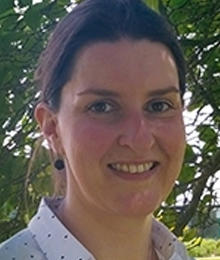An interview with Dr Helen Brown
December 2019
Dr Helen Brown is a Postdoctoral Researcher at Cardiff University with the focus of her research being on biofilms. In this interview, she talks about the importance of her research and development of new therapeutics.

Tell us more about your research.
I am a Postdoctoral Researcher at Cardiff University. My research interests predominantly focus on the biology of biofilms. I’m interested in how interactions between different bacterial and fungal species can modify the resistance and persistence profile of the biofilm. Knowing more about how the species interact allows us to develop more effective treatment strategies for infections caused by biofilms.
Biofilm infections are a significant problem for clinicians as they are inherently more reticent to antimicrobial treatments. Alongside this, the proximity of microbes to one other allows them to exchange genetic material, easily allowing the spread of antibiotic resistance genes throughout the population, making them even harder to treat.
Biofilm infections are a problem within the lungs of people with cystic fibrosis, within chronic wounds and following surgical implants. My current research projects focus on developing a novel antibiofilm treatment for chronic wounds and how the presence of commensal bacteria within wounds can alter the biofilms of opportunistic bacterial pathogens such as Staphylococcus aureus.
Why is this research important?
This research is particularly important as we currently have very limited ways of treating biofilm infections. Often people suffering from chronic wounds have comorbidities (such as diabetes or circulatory problems), further complicating their treatment and reducing the likelihood that wounds will heal well and quickly.
Currently the best method of treating biofilm infections within wounds is to debride any infected tissue thoroughly and then treat the patient with long courses and high doses of antibiotics. Often antibiotics are given in combination to reduce the possibility of any remaining bacteria within the wound site developing antimicrobial resistance.
These treatments are prolonged, often painful and require repeated clinic visits, seriously impacting the patient’s quality of life. Even with these prolonged treatments healing of the wound site is not guaranteed, with some patients requiring years of treatment or, in severe cases, amputation of infected limbs.
How can clinicians develop more novel ways to treat chronic wounds?
In order to more effectively treat and heal these wounds we need not only to have a better understanding of their biology, but also develop novel treatments. A better knowledge of the chronic wound will allow clinicians to target treatments more effectively, selecting options that are the most likely to succeed for each individual.
Novel therapeutics will also give clinicians a greater choice of treatment options, so if the bacteria within the wounds show some antibiotic resistance, we will still have alternatives for treatment. I hope that my research can contribute to resolving chronic wounds more quickly and with less pain; because who knows, one day I might be the person who has a chronic wound.


